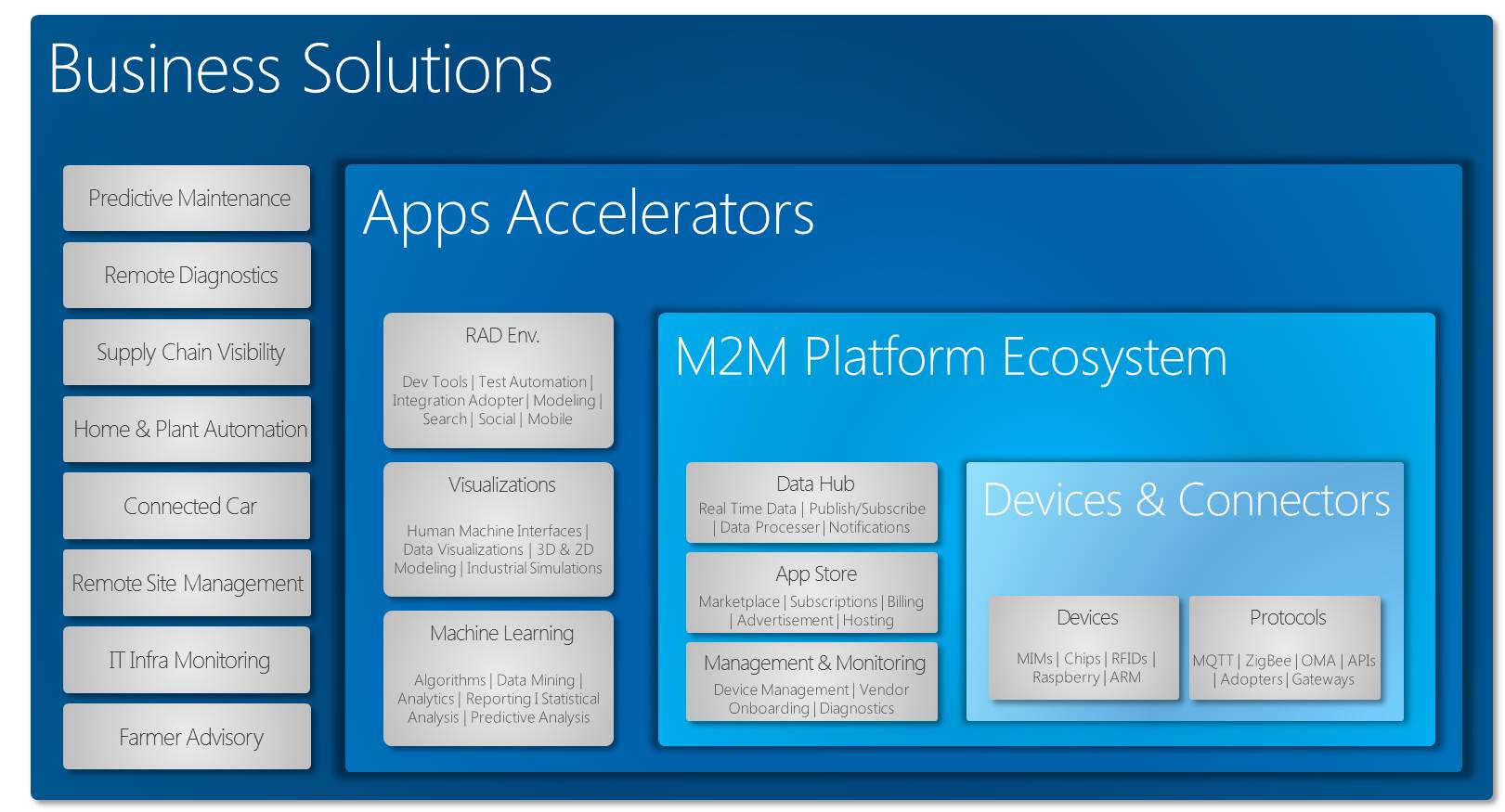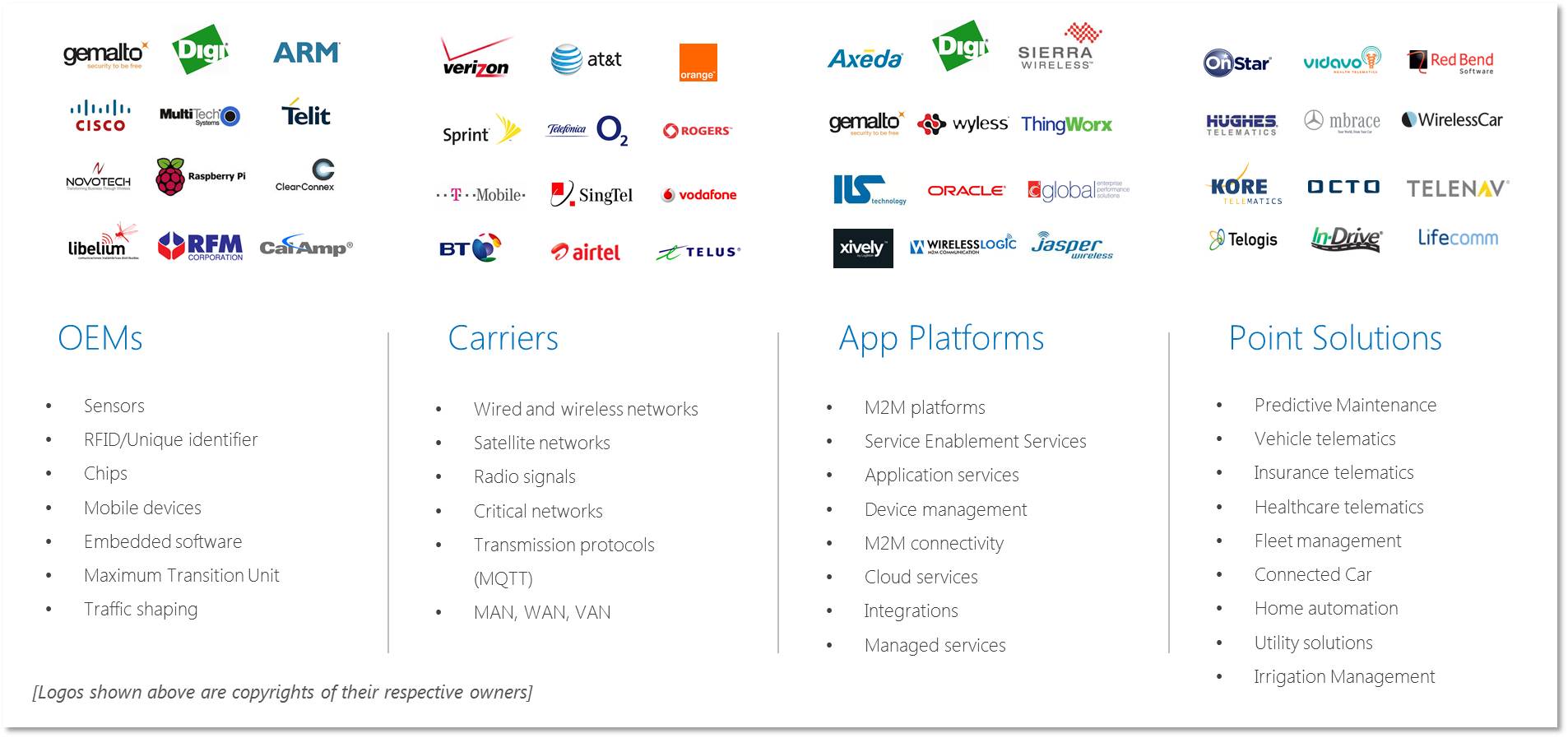IoT/M2M is transforming the way organizations do their business by collecting data from remotely located machines or equipment and applying it in ways that impact their business. IoT is no longer a buzz word, and embracing it no longer an option for organizations that wish to stay competitive. Recent research from Cisco also substantiates the same, as “M2M has already generated $613B in corporate profits in 2013 and $544B is still up for grabs by end of the year.” Given the scale of adoption, it might be good for us to understand the IoT/M2M ecosystem and how it is evolving.
The IoT/M2M Ecosystem
The current M2M technology landscape is complex and filled with multiple players. The technology landscape can be broadly categorized into four layers as mentioned below:

Layers in M2M Technology
Devices & Connectors are seen as primary source and feed of information in a typical M2M solution. The advances in remote device identification, data collection, data filtering, device connectivity, data transportation, device management and more have really simplified the low level enablement. E.g. RFIDs, sensors, chips, MIMs, gateways, ZigBee, MQTT, OMA, APIs, ARM, Raspberry, Digi devices, Jasper Wireless, Wyless.
M2M Platform Ecosystemcomprises platforms and services, which simplify M2M application enablement through seamless device connectivity, data management, high availability and accessibility across verticals. M2M platforms, data hub, marketplace, cloud services, device management, integrations, service enablement services, data access and integrations are typically covered here. E.g. Axeda, Digi Cloud, Gemalto, Eurotech.
Apps Accelerators in rapid application development, testing, reporting, visualizations, industrial simulations and machine learning can expedite M2M application development and deployment across verticals. Providers of these accelerators constantly innovate to have cross vertical accelerators and help bringing down the costs associated with M2M enablement. E.g. ThingWorx, Bosch, Grok.

Key players in M2M Technology (illustrative). Logos shown above are copyrights of their respective owners.
The ecosystem is vital for achieving the business value of M2M solutions. The traditional way of M2M business development, where value chain is more horizontal, has posed many challenges through increased costs, inflexibility and decreased innovation.

Traditional M2M Ecosystem Value Chain
However, these challenges can be addressed through vertical expansion of M2M platforms and accelerators that started off late and well-constructed strategic alliances.Quietly,these two are becoming the heart of the ecosystem
- M2M platforms and app accelerators have lots of potential for vertical expansion across industries and businesses. We have seen good progress in the last two years with number of M2M platforms coming out in the market with features such as device connectors, device management, device cloud, data management, data availability, seamless connectivity and dashboards. However, these platforms have a long way to go, adding features such as remote diagnostics, predictive analytics and machine learning.
- With multiple players trying to latch onto opportunities created by the IoT, it is going to be difficult for organizations to adopt M2M and realize business value unless these players come together and work towards mutual benefits. Making strategic alliances with providers of network, hardware, M2M platforms and accelerators will become more relevant for building successful M2M solutions.

M2M Ecosystem with Scope for Vertical Expansion
The current M2M ecosystem is going through consolidation. Recent acquisitions -- Telit acquiring ILS Technology, Digi acquiring Etherios, Wipro investments in Axeda and Gemalto acquiring SensorLogic -- are supporting this, and we might even see more of such activities in a coming year or so. Through alliances or acquisitions, network carriers are trying to seize the opportunity with additional offerings in the form of M2M services such as device cloud, device connectivity, device management, integrations, vertical solutions, etc. along with their regular network services.
To simplify and scale up M2M adoption, M2M adopters and network carriers are emphasizing on the development of “horizontal” standards independent of industries. Key standardization initiatives such as MSTF, ETSI, 3GPP, oneM2M and MQTT are underway to simplify the communication and bring uniformity to M2M implementations across verticals.
Advancements in sensor technology, the emergence of M2M platforms and app accelerators, and industry consolidation and standardization are bringing M2M technology within the reach of organizations and reducing deployment lead time from years to weeks. This is a significant improvement. To be competitive, organizations should embrace M2M technology and look at options to derive value out of connected devices, at least on the ones that are already connected. The M2M platforms evolution pace, innovations in sensors and battery technology, and progress in standardization will soon bring the IoT and M2M within the reach of everyone. I think that is just around the corner.
 Sudheer Polavarapu is a Technology Architect within Manufacturing unit at Infosys. Sudheer focuses on introducing and enabling new technologies into the mainstream and deriving business value through consulting and innovation.
Sudheer Polavarapu is a Technology Architect within Manufacturing unit at Infosys. Sudheer focuses on introducing and enabling new technologies into the mainstream and deriving business value through consulting and innovation.
He has over 12 years of experience working on several enterprise software engineering and IT initiatives. His areas of expertise include technology and consulting in scalable architectures, high performance applications, and service-oriented architecture (SoA). He also has extensive experience in Mobility, Application Programming Interface (API) management, IoT, and Web applications.
Edited by
Rachel Ramsey





